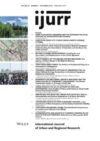October 17th 2020 marks the one year anniversary of Lebanon’s uprising. In this occasion, we look back at the first months of the protests to recover some of the inspiring lessons that can be derived from transgressive activists’ practices. To this end, we explore in this short essay the numerous forms of space appropriation that protestors deployed in October-December 2019 and recall how these practices introduced processes of urban transformation that Lebanese authorities had failed to initiate since the end of the civil war (1975-1990). As scholars invested in the progressive potential of the profession of city planning, we found in the audacious occupation of abandoned theaters, parking lots, city streets, and public squares in numerous Lebanese cities a new repertoire of action that should inspire city planners in this age of rampant privatization. Months later, and with the added effects of a financial meltdown, a severe economic crises that leaves 50% of the Lebanese population below the poverty line, the lockdowns and health risks imposed by a rampant pandemic, and a massive explosion that ravaged numerous quarters of Lebanon’s capital and devastated its port, the nature of the street practices has changed considerably. Yet the political imaginaries instigated by the moment of uprising provide a valuable repertoire of action that is worth documenting and dwelling on.
Almost every city in Lebanon developed its version of an extraordinary public life in the weeks following the first protests. Beirut, Tripoli, Saida, Tyre, or smaller towns such as Nabatiyeh or Jall ed-Deeb acquired each a recovered public space where people of all walks of life gathered to participate in teach-in sessions or collective debates where questions of political transformation, activist organization, accountability for corrupt decision-makers, financial bankruptcy, strategies of non-violent resistance, economic solidarity, or psychological resiliency were discussed. The spaces they used took up different forms, depending on the political, physical, and historical contexts of the cities.
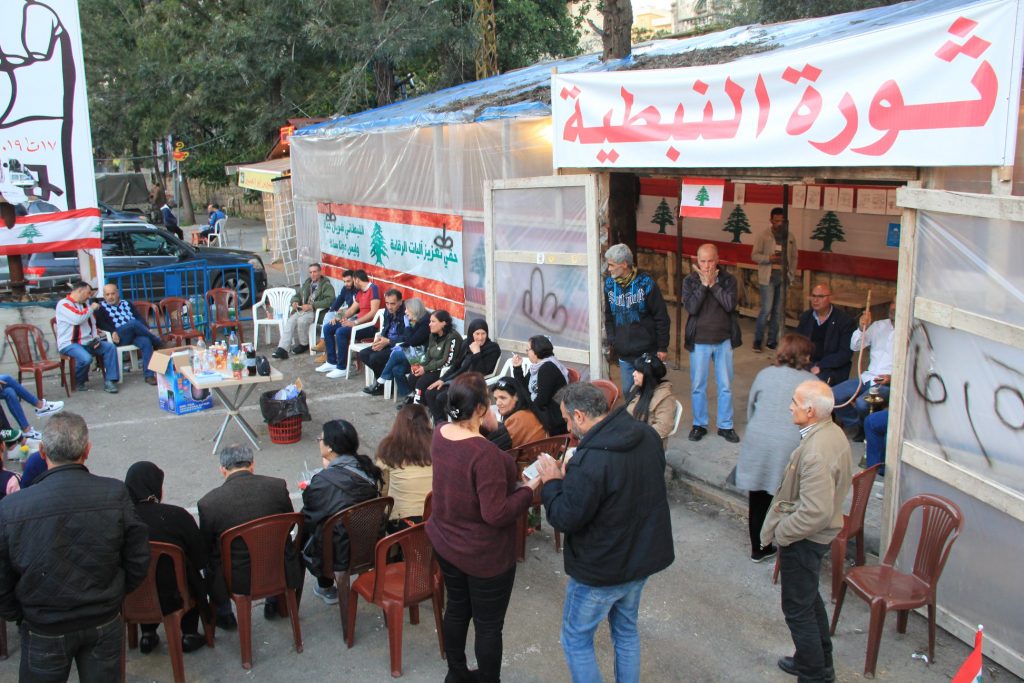
Daily gatherings on the streets of Nabatiyeh. The tent’s sign reads ‘Nabatiyeh’s Revolution’. Photo: Hussein Maaz.
Thus, in Tripoli, Sahet el Nour, the forgotten entrance of the city’s old souks now turned into a dilapidated city core, was rediscovered by the city’s youth and more widely, by the activists of the country (Takriti 2019). On this square, a well-known DJ played loud music every evening as the square came to life and became a landmark for the revolutionaries. Elsewhere, the city of Nabatiyeh in South Lebanon revealed an unsuspected revolutionary public. Known for the yearly commemoration of the religious event of Ashoura, Nabatiyeh is branded as the undeniable seat of Muslim Shia political parties in South Lebanon. The city’s public spaces are associated with the unshakable control of these political parties, as demonstrated by banners, posters, and the visible presence of strongmen who strictly monitor social practices. For a few fleeting weeks, the emancipatory potential of the streets and roundabouts of Nabatiyeh displaced their association with strict religious and political observance. Instead, dance mobs, discussion sessions, and artistic performances invited participants from different parts of the country, young and old, men and women, to share in the celebration of the newly found public. Meanwhile, in Jall el Deeb where the development of a large-scale highway intersection in the two years preceding the Lebanese Uprising had rendered the area notorious for its traffic jams, activists took to closing daily the highway and appropriating the spaces below the bridges for their daily events.
The center of the uprising was naturally Beirut’s historic core where activists reinvented the exclusive playground of the rich through a new program that includes soup kitchens, free psychiatric clinics, piazzas for regular public debates, performance spaces, and meeting areas, among other functions. For a few months, the large-scale abandoned lots, vast parking areas, and wide roads dedicated to cars were animated by daily marches where chants recurrently denounced sectarianism, the rule of the corrupt, and the oppression of crony capitalism. For weeks, they found their echoes in the clanging pots and pans that marked the city’s anger every evening at 8pm. Meanwhile, graffiti were on almost every wall. Stencils, spray paint, and large murals affirmed protestors’ rejection of Lebanon’s political class. They embodied aspirations for a second republic where women are equal citizens, LGBT rights are respected, and, –most importantly- crony capitalism is curtailed and social justice prioritized.
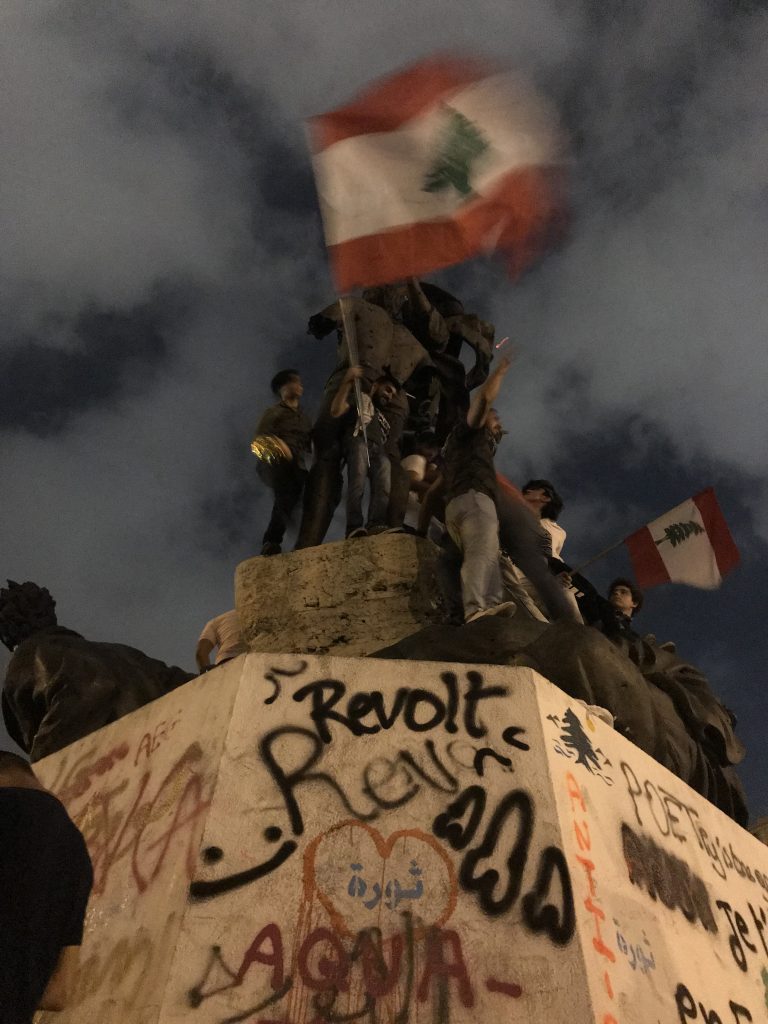
Protestors raise the Lebanese flag on the graffiti covered Martyrs’ Monument in downtown Beirut. Photo: Isabela Serhan.
To understand the political significance of these transgressive practices, one needs to revert to the project of Beirut’s post-civil war reconstruction. Beirut downtown, the center of the 2019 protests, had been turned into a no-man land for most of the 15 years of civil war. Its so-called reconstruction in 1990 had been delegated to a private real-estate company, Solidere (Makdisi 1997). At the time, the forceful pooling of property was justified by the vision of a high-end city core that would attract multi-national companies and provide job opportunities for Lebanese youth. The promise failed to materialize. Instead, downtown Beirut was turned into exclusive real estate. To boost the exchange value of land, the city’s historic core was adorned with high-end malls and expensive restaurants. As inequality rose and the corruption of the political elite became flagrant, security was intensified. Its militarized visible deployment drove away many users and precipitated the closure of many public and private venues (Fawaz et al 2012). Conversely, the handful of preserved public venues such as the Egg or the Grand Theater remained dead relics in the absence of an economic rationale that would justify their activation
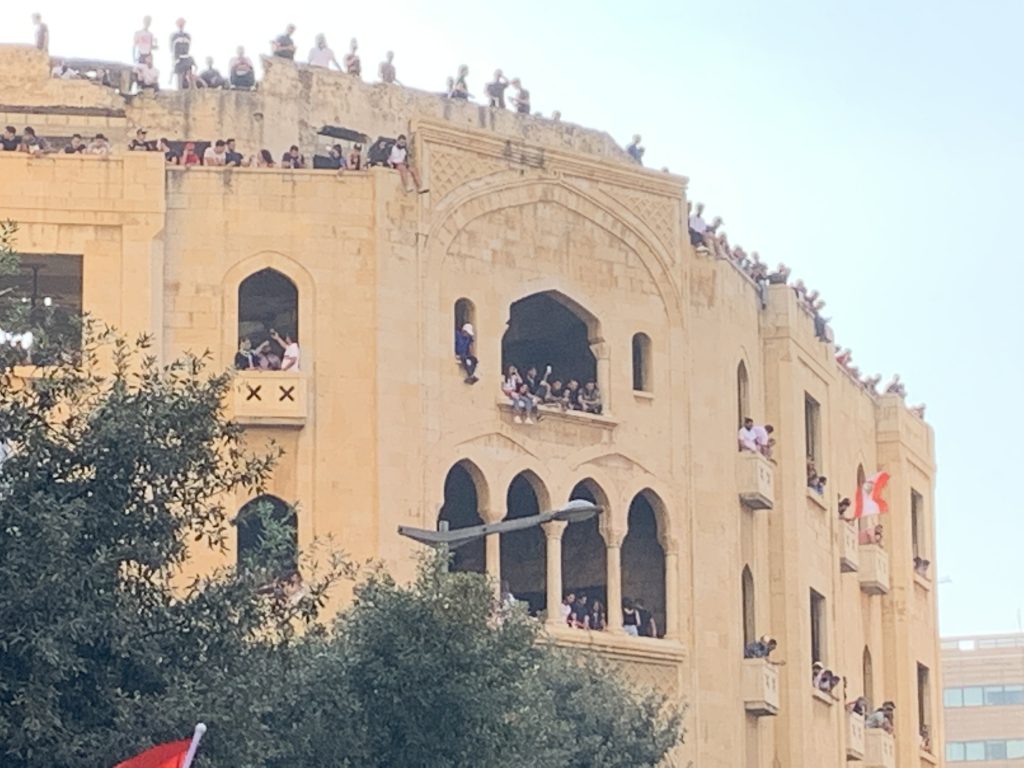
Protestors occupying the abandoned building of the Grand Theater in downtown Beirut. Photo: Mona Fawaz.
In October 2019, activists were keen on challenging privatopia. They turned the severed historic core into the headquarters of their action. They built their tents on private property, demonstrating through these newly established sites of operation the possibility of reorganizing Beirut’s historic core into an actual lived space. Their activities expanded to closed-down public venues that they reclaimed as sites of discussion and mobilization. Thus, the derelict Egg, a building that ironically was incomplete at the outbreak of the civil war, gained for the first time a resounding public life. Here, professors and students organized teach-ins during the mornings, while public debates about national challenges were held in the afternoon, and rave parties were scheduled in the late hours of the night, ultimately filling an official round the clock timetable (Mackenzie 2019). The reclamation of space also expanded to areas falling within the private domain, such as land lots earmarked for development, demonstrating yet one more time that property boundaries are imagined and privatization is consequently reversible, despite the neoliberal narrative (Blomley 2004).
These are but a few examples of the activation of a public program that expanded public space and allowed activists to network across them. For the first time, people across Lebanon learned to recognize and name public squares and streets occupied by the ‘revolutionaries’ of other cities, a shared national identity was being built from the groups up.
Public activities found in social media important platforms for organization, mobilization, and free expression. Online platforms were flooded with stories of shared activities in public spaces. Furthermore, a vibrant community of illustrators and designers translated narratives of legal rights and campaigning plans into short videos and images that went viral via Whatsapp and Telegraph communication groups as well as social media. They became essential to sharing information and rallying protestors when needed, such as for blocking parliamentary sessions where undesirable decisions would be taken. Meanwhile, to maintain their place and relevance, regular media airways had to also reclaim their space in the squares. Most TV stations set-up temporary positions in Beirut’s historic core as well as other squares across the country. They aired political debates and talk shows daily from the square, widening their audiences.
In reclaiming a shared space, activists were ultimately enacting the possibility of building new political collectivities. A society that had collectively chosen amnesia over accountability and reconciliation and fallen into an excessive consumerist model with vast social inequalities was looking for a new skin. Such collectivities come together to embody an alternative political imaginary, one where being together is based on the shared aspirations of a life in dignity and mutual respect. Scenes of women occupying the front line to close roads or stand up to the police force rapidly translated into feminist demands for equal rights and respect. The closure of roads often brought about a romantic imaginary of what pedestrianization could mean if cars were not prioritized in the planning of cities. Meanwhile, neglected commons, privatized public beaches, and locked down parks symbolized to many the failure of the state project in the country. They debunked the possibility of considering public agencies as the possible custodians of a “common good”, as is typically assumed in western democracies (Madanipour 2010). Instead, the illegal uses of the commons, often secured through the protection of powerful political figures and/or used directly by members of the political class, reflected eloquently the corruption that plagues the government of the nation.
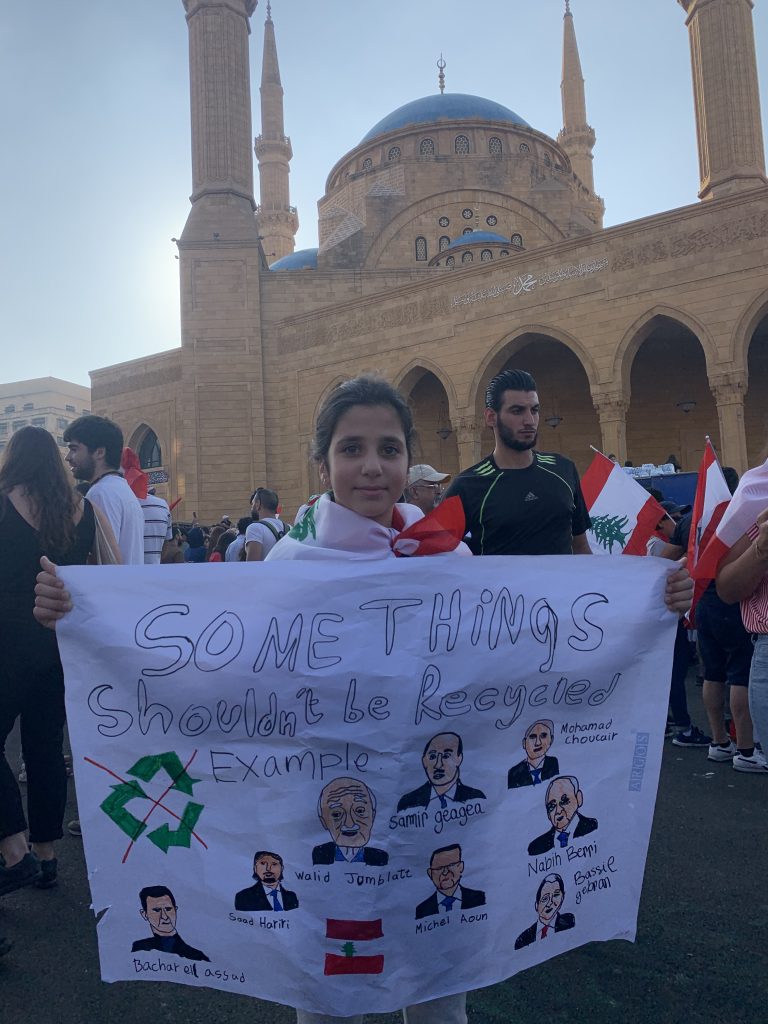
A common poster in Lebanese protests depicted the country’s leaders and politicians as ‘non-recyclable’ material. Photo: Mona Fawaz.
Thus, activists denounced the illegal occupation of the seafronts and went as far as setting on fire an exclusive resort in the Southern city of Tyre that restricted public access to the beach. Similarly, the classed, gendered, and heavily securitized management of the commons was denounced as another piece of evidence of Lebanon’s failed citizenship project where women, refugees, migrant workers, and working classes are disrespected. This awareness expanded to the loss of the natural environments nationally, shedding light on the ecological movements who had until then denounced dams, quarries, and other large-scale infrastructures within their own environmental silos.[1.] Ultimately, the loss of public space was equated with the loss of public rights, corruption as the squandering of public spaces and natural ecologies was equated to the embezzlement of public coffers. Their reclamation as an inclusive and humane space became a central element of the project to reform the nation as a country of equal citizens.
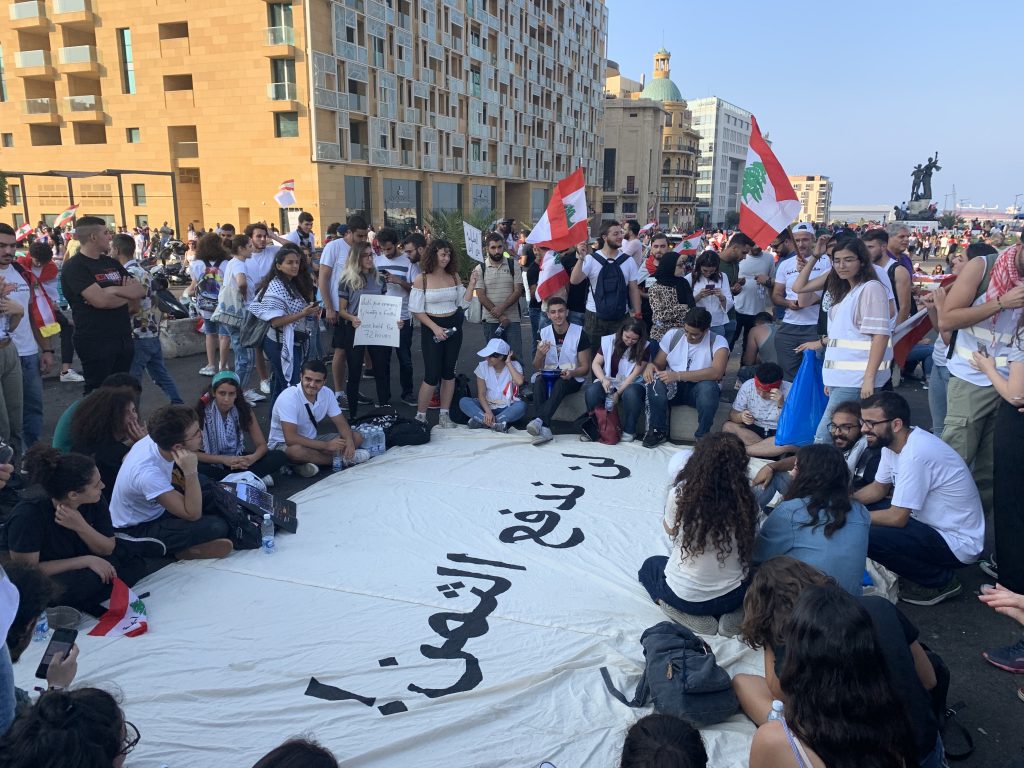
‘We won’t pay the price’. Photo: Mona Fawaz.
“Space is political”, famously wrote the French philosopher Henri Lefebvre whose cry for a right to the city still inspires generations of urban activists. “Every society creates its own space”, and this space reflects its modes of organization and reproduction, in other words the values that glue it together (Lefebvre 1969). Herein lies the political significance of the actions perpetrated by Lebanon’s protestors. In Lebanon’s cities, the direct reclamation of space through transgressive acts defied both state authority and market rule to affirm the existence of hopeful collectives capable of imagining alternative tomorrows based on social solidarity and inclusive city-making. The values their actions embodied are dismissed as “irrational” by the dominant logic of capital. As the financial crisis sharpens throughout the country, however, the repertoire of action these activists developed provides unique inspiration for planners and architects invested in the progressive potential of our professions. They require us to invent the institutional frameworks that can shift these temporary tactics into long term, sustainable strategies of city making.
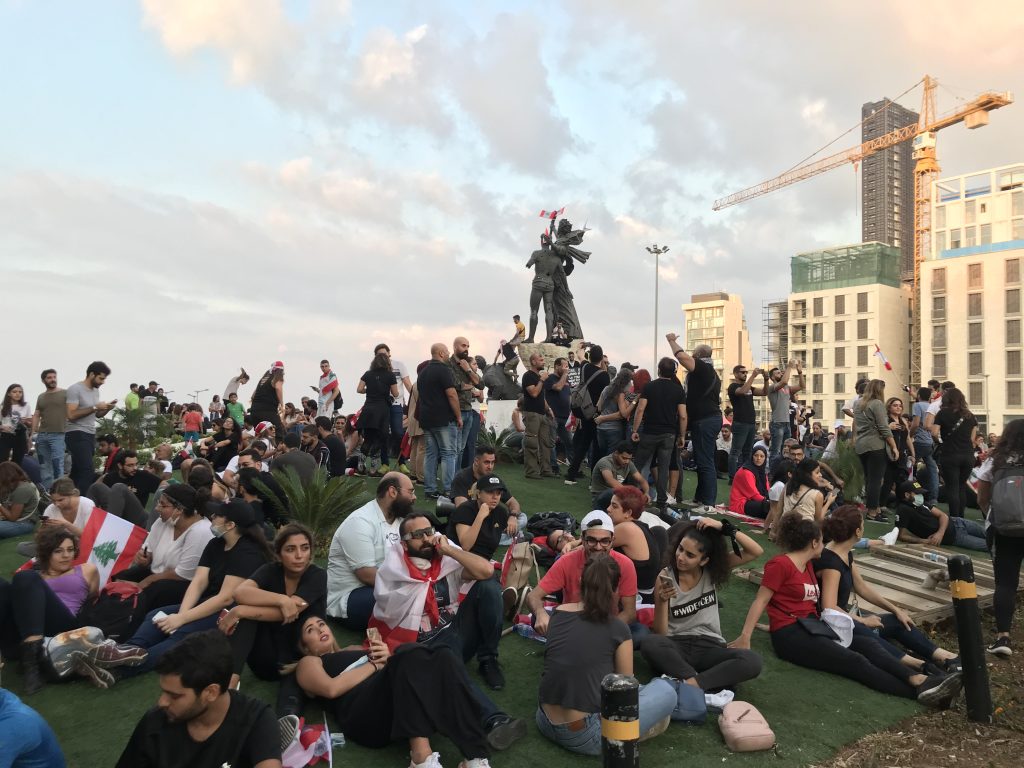
Round-the-clock occupation of Martyr’s Square in downtown Beirut. Photo: Isabela Serhan.
Mona Fawaz (Twitter) is Professor in Urban Studies and Planning at the American University of Beirut. She is also a co-founder of the Beirut Urban Lab, a recently established research center that engages policymakers, activists, and researchers in Lebanon and the region on questions of urban inclusion and post-conflict recovery. She is the author of over 50 articles, reports, and book chapters investigating issues of housing, informality, property, law, and planning theory and pedagogy.
Isabela Serhan (Twitter) is a researcher at the Beirut Urban Lab. She is an architect and is currently pursuing a master in urban planning and policy. Her interests are at the intersection of social justice and urbanization – particularly public space and housing.
All essays on Urban Revolts
Introduction: The Spatiality of Street Protests before and during Covid-19
Liza Weinstein
When the Pandemic Meets the Insurrection. Santiago, Chile
César Guzmán-Concha
Urban Revolutions: Lebanon’s October 2019 Uprising
Mona Fawaz & Isabela Serhan
The Revolt of the “Periphery” Against the “Metropolis”? Making Sense of the French Gilets Jaunes Movement (2018-2020)
Claire Colomb
An Urban Perspective on the Colombian “Paro Nacional”
Sergio Montero & Isabel Peñaranda
The Predicament of Hong Kong and the Spatial Expanse of Territorial Governance
Carolyn Cartier
Published online October 2020
Related IJURR articles on Urban Revolts
Institutionalization and Depoliticization of the Right to the City: Changing Scenarios for Radical Social Movements
Sergio Belda-Miquel, Jordi Peris Blanes and Alexandre Fredian
Do‐it‐yourself urbanism and the right to the city
Kurt Iveson
Glocalizing protest: urban conflicts and the global social movements
Bettina Köhler, Markus Wissen
Permitting Protest: Parsing the Fine Geography of Dissent in America
Don Mitchell, Lynn A. Staeheli
The Urban Question Revisited: The Importance of Cities for Social Movements
Walter J. Nicholls
Urban Segregation and Metropolitics in Latin America: The Case of Bogotá, Colombia
Joel Thibert, Giselle Andrea Osorio
© 2020 THE AUTHOR. INTERNATIONAL JOURNAL OF URBAN AND REGIONAL RESEARCH, PUBLISHED BY JOHN WILEY & SONS LTD UNDER LICENSE BY URBAN RESEARCH PUBLICATIONS LIMITED
This is an open access article under the terms of the Creative Commons Attribution-NonCommercial-NoDerivs License, which permits use and distribution in any medium, provided the original work is properly cited, the use is non-commercial and no modifications or adaptations are made.
